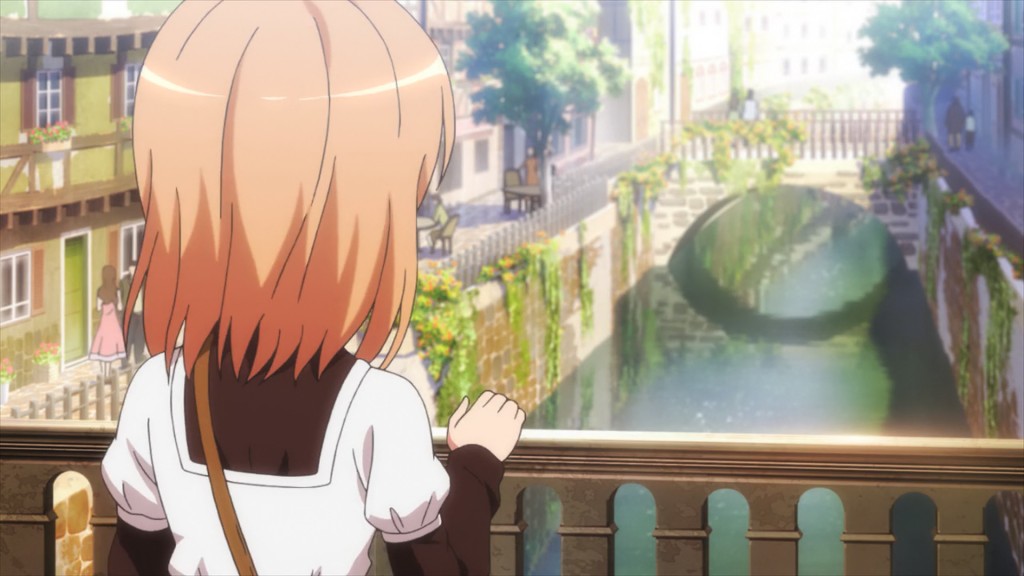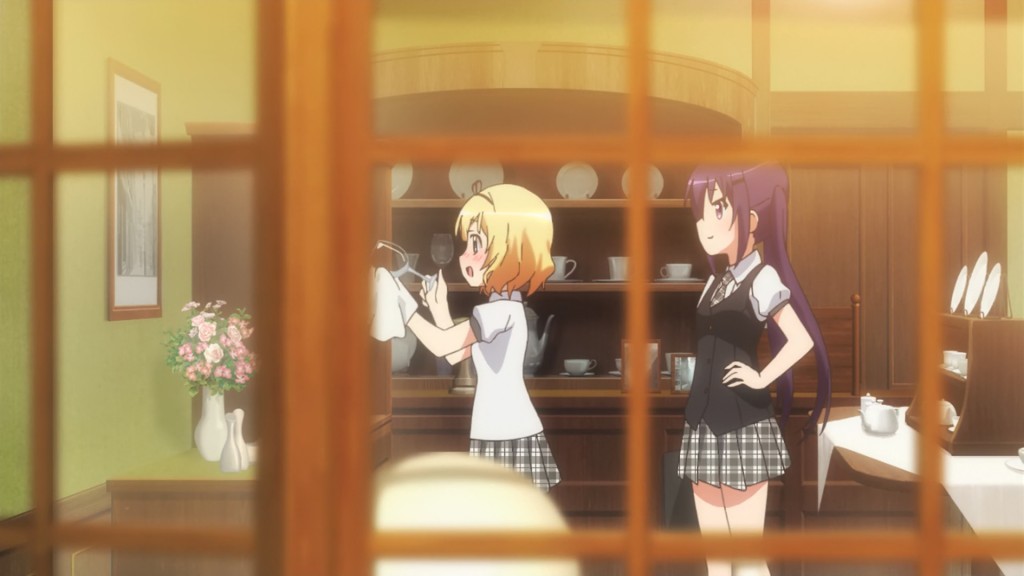Studio: White Fox
Length: 12 Episodes x 25 Minutes
Season: Spring 2014
Release: Streaming (Crunchyroll)
If Is the Order a Rabbit? looks familiar, you wouldn’t be too far from the truth, with comparisons to its visual style clearly drawn from last year’s moe hit Kiniro Mosaic. Both series are pulled from the pages of Manga Time Kirara Max, one of the Manga Time Kirara seinen manga magazines published by Houbunsha, which markets its cutesy style to the late-teen and young adult male audiences and has seen the likes of K-On!, Acchi Kocchi, and Yuyushiki run through its pages, and has even produced a special magazine dedicated to Pullela Magi Madoka Magica.
If you’re familiar with any of these properties, you’ll feel right at home with Is the Order a Rabbit? and its slow, relaxing slice-of-life format. In a departure from its school-based brethren, Is the Order a Rabbit? is set in a picturesque town with French inspiration – medieval style buildings dominate, with criss-crossed wooden panels decorating the fronts of buildings, bordered by a small river which runs through the centre of town. It’s beautifully crafted to be an idyllic environment full of artisans and well-to-do café owners.
The Rabbit House is one such café, and is the centre point of the series, as we delicately peek into the lives of its schoolgirl employees, who in the name of exceptional taste are all named after beverages. The central character is Cocoa Hoto, who moves into town on a pre-arranged homestay. After wandering around town, Cocoa stumbles across The Rabbit House and steps inside, expecting the café to be filled with rabbits; (an interesting reference to themed animal cafés that are particularly popular in Japan, especially with women) but is inevitably disappointed with the lack of bouncing bunnies.
The only rabbit in the café is Tippy, a round white ball of fuzz that sits on the head of Chino Cafu, daughter of the café’s owner. Tippy is designed to be 110% cute, and despite looking nothing like a typical rabbit at all offers a good section of the entertainment. The girls don’t just fawn over him either, there is a tender plot surrounding the rabbit, which involves a budding writer, a book-turned-film, and a good cup of coffee.
And to her surprise, that’s what Cocoa ends up making herself. Her homestay is at the café, and to pay for her accommodation she takes up the apron and uniform alongside Chino and her other teenage colleague Rize Tedeza, who has an abnormal and almost-otaku appreciation of firearms. The core focus of the series is on the relationship and interactions of these three, along with Cocoa’s classmate Chiya Ujimatsu, whose family runs a Japanese themed café, and her friend and fellow waitress Sharo Kirima. The character designs and artwork feel very soft, but the usual stereotypes are used, and even familiar voice actresses appear (who are commonly typecast), with Taneda Risa handling the tsundere style in Rize, similar to Aya Komichi in Kiniro Mosaic. The girls still each have their own distinct personalities, and despite their differences and shortcomings (there’s a particular gag about Sharo being labelled as a rich girl when she is actually poor) come together well and provide entertaining interaction.
The story is more episodic, and despite common threads is safe to jump in almost anywhere as long as you’ve seen the first couple of episodes which do the character introductions. The style is stripped directly from its source’s four-panel format, and works well to create a series that is heart-warming and easy to understand; and as a result seems like a decent entry-point to genre newcomers. Sticking in long-term is rewarding though, as we see the relationships between the characters develop. The difference in Cocoa between the first and last episodes is astounding in how she has adjusted to her new life at The Rabbit House – going from total newbie to very much part of the latte art producing team. The rest do feel closer to both viewers and each other by the time the end rolls around, but it would have been nice to see more changes in a couple of the girls and to have Rize’s gun relationship explained and explored further. The story impresses in its ability to stay engaging despite its slow pace, with some nice set-ups in the middle. A Christmas episode near the end makes this a good series to watch during the festive period, although it felt odd to watch during its original June airdate.
While production studio White Fox haven’t been around as long as other studios, their experience with their previous works; such as the classic Steins;Gate and entertaining comedy The Devil is a Part-Timer!; shows with good animation quality and an art style which stays true to the source material. There’s nothing overtly special about it, and in fact shows a more medium level of budget, but for a show such as this you want something that is light and easy on the eye, and that’s just what it delivers. The cast perform well for this kind of show, delivering majoritively high-pitched, feminine work that comes off girly without being too grating on the ears; while offering their vocals for the catchy opening theme “Poppin’ Jump♪”. The rest of the soundtrack has a very Parisian feel, working well with the setting and visual design. It’s more of a subtle, relaxing ambience that hides behind the girls’ coffee-making adventures and can be under-appreciated when the focus is on the vocals.
There’s only so much you can do with shows based on the lives of cute young girls; but with its Parisian styled café setting, Is the Order a Rabbit? comes off as one of the freshest for a while. It’s a relaxing and heart-warming tale of a group of girls uniting around coffee, while not being anything overly special or outstanding – very much like your favourite brew.
7/10 – Good



